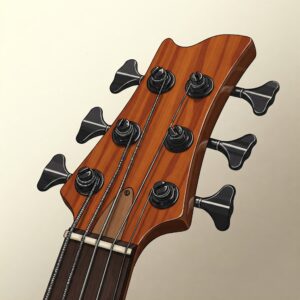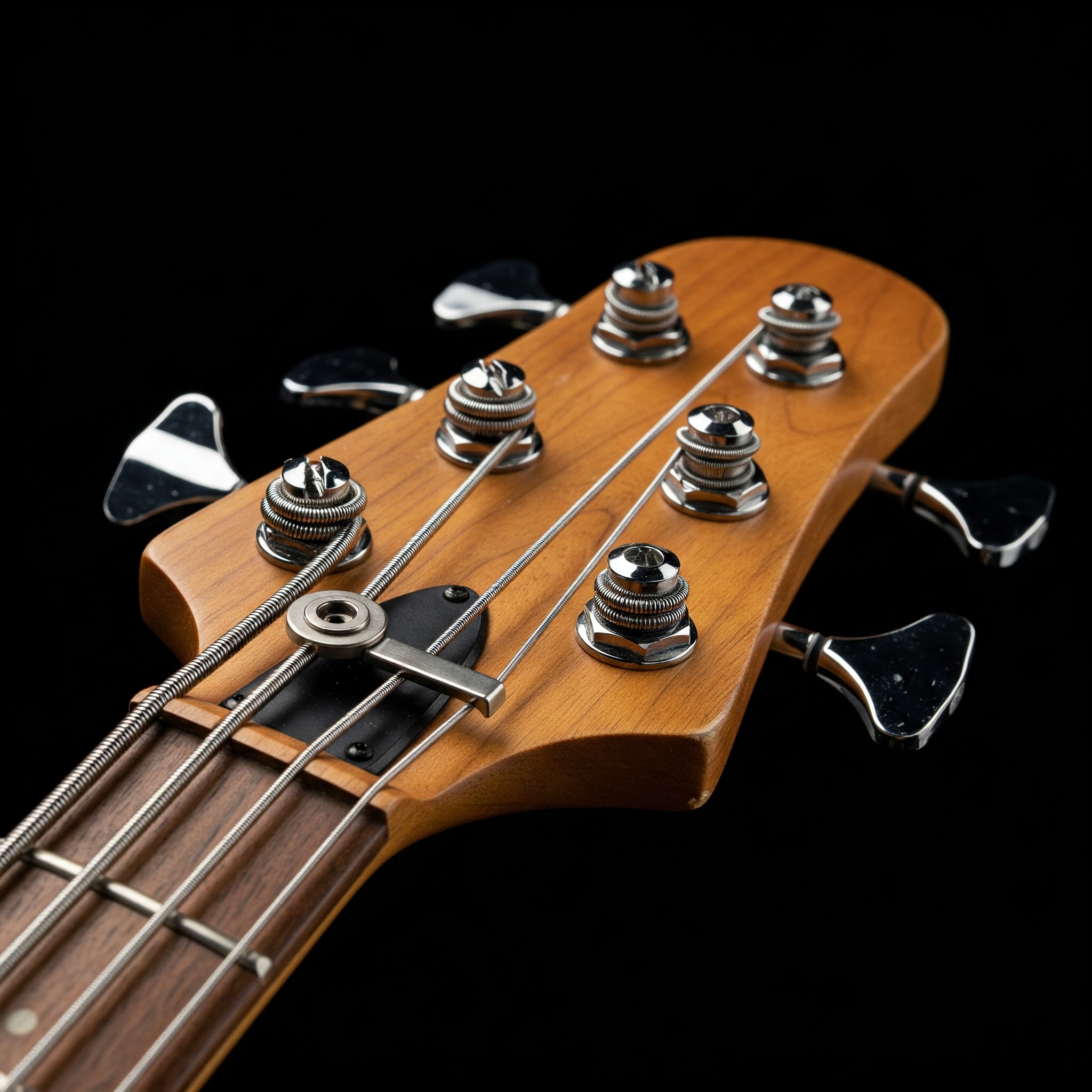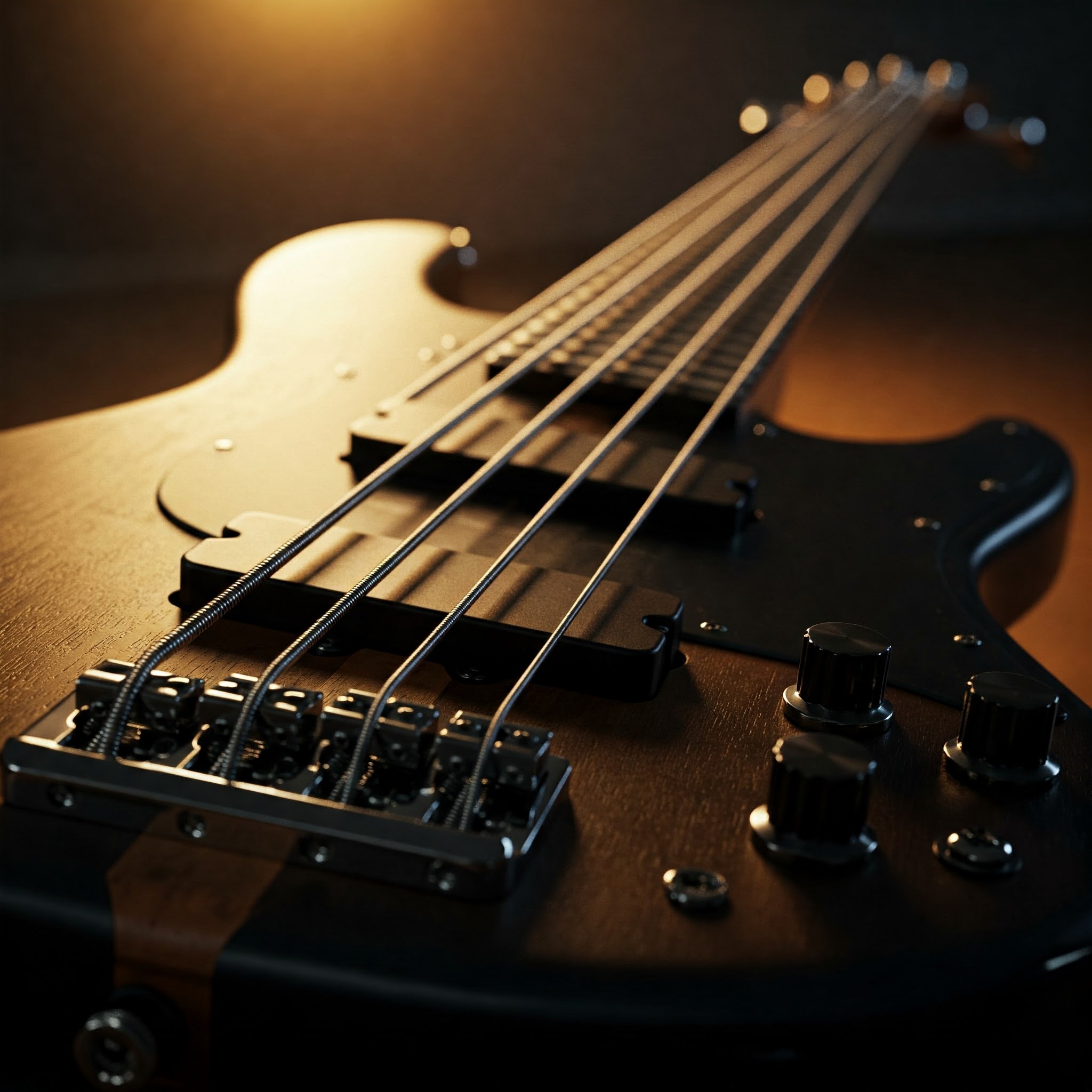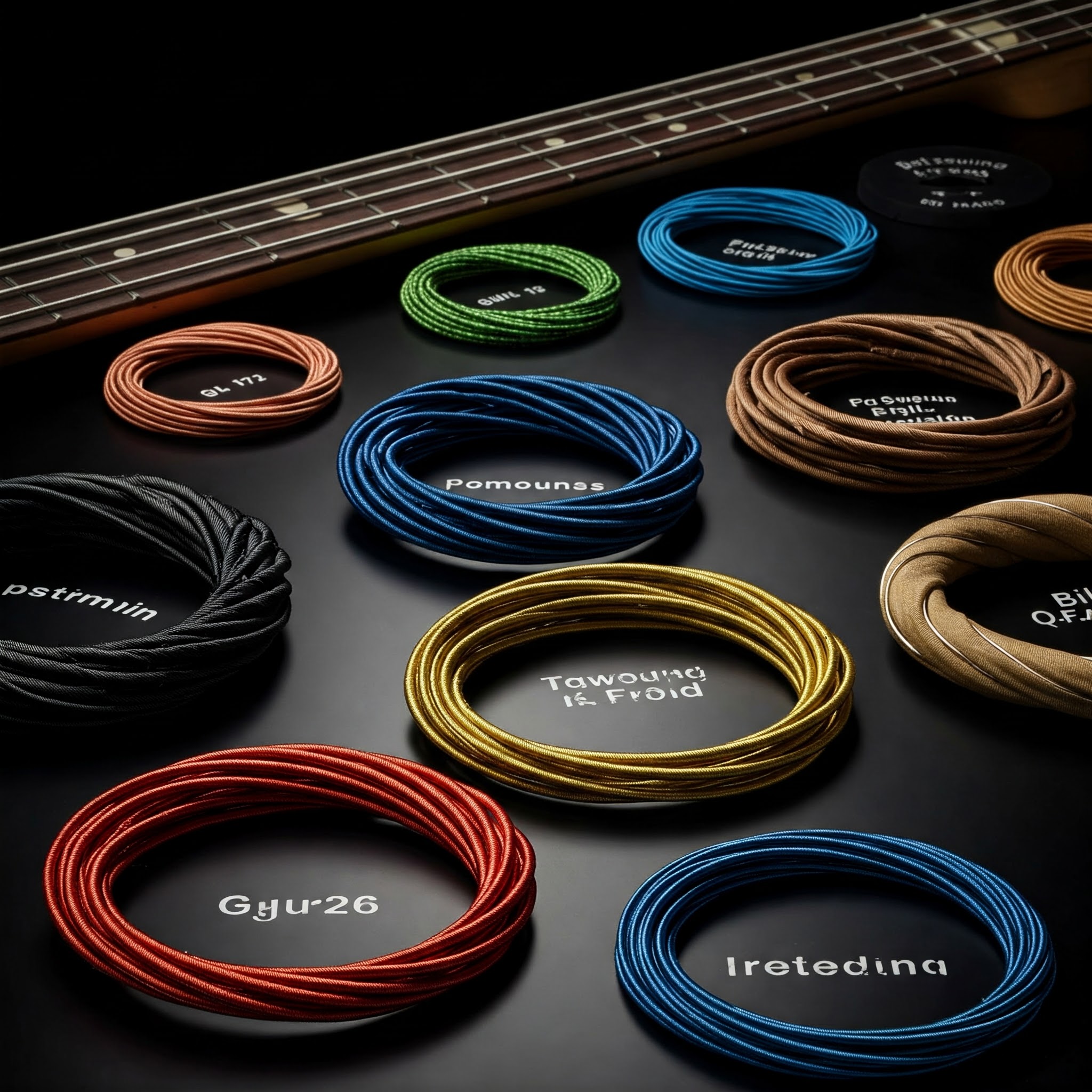Are you ready to take your bass playing to an entirely new dimension? The 6 string fretless bass represents one of the most expressive and versatile instruments in the modern bassist’s arsenal. Whether you’re a jazz fusion enthusiast, an experimental musician, or simply looking to expand your tonal palette, this comprehensive guide will walk you through everything you need to know about the fascinating world of 6 string fretless bass guitars.
✨Was this helpful? Spread the word! 🚀
As a professional bassist with over 15 years of experience playing both fretted and fretless instruments across multiple genres, I’ve had the opportunity to test dozens of 6 string fretless bass models. I’ve experienced firsthand the unique challenges and incredible rewards these instruments offer, and I’m excited to share that knowledge with you today.
The 6 string fretless bass combines the extended range of a 6 string bass with the smooth, vocal-like quality of a fretless fingerboard. This combination creates an instrument capable of incredible expressiveness, allowing for microtonal inflections, seamless glissandos, and a warm, mwah-rich tone that simply can’t be achieved on a traditional fretted bass.
But before we dive deep into the specifics, let’s take a moment to compare a standard 6 string fretless bass with its alternatives to help you understand exactly what makes this instrument so special:
| Feature | 6 String Fretless Bass | 4 String Fretless Bass | 6 String Fretted Bass | 5 String Fretless Bass |
|---|---|---|---|---|
| Range | Typically B to C (5+ octaves) | Typically E to G (3+ octaves) | Typically B to C (5+ octaves) | Typically B to G (4+ octaves) |
| Tone | Warm, vocal-like with “mwah” | Warm, vocal-like with “mwah” | Defined, precise | Warm, vocal-like with “mwah” |
| Learning Curve | Very steep | Steep | Moderate | Steep |
| Versatility | Extremely high | Moderate | High | High |
| Price Range | $800-$5000+ | $400-$3000+ | $500-$4000+ | $600-$4000+ |
| Ideal Genres | Jazz, fusion, experimental | Jazz, fretless rock, world | Rock, metal, funk, jazz | Metal, jazz, fusion |
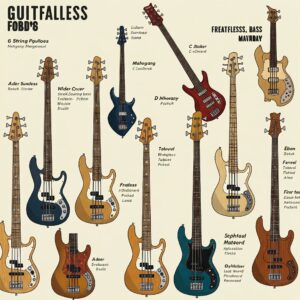
What is a 6 String Fretless Bass?
A 6 string fretless bass is exactly what the name suggests – a bass guitar with six strings and no frets on the fingerboard. Traditional bass guitars typically have four strings tuned to E-A-D-G, while a standard 6 string bass adds a low B and a high C, expanding the range considerably in both directions. The fretless aspect means that instead of metal frets embedded in the fingerboard to define specific pitches, the fingerboard is completely smooth, similar to upright basses or members of the violin family.
The 6 string fretless bass offers an incredible range of over five octaves, allowing bassists to explore both deep, rumbling lows and soaring melodic highs all on one instrument. Without frets, players can execute subtle pitch inflections, vibrato, and glissandos that are impossible on a fretted instrument. This combination makes the 6 string fretless bass one of the most versatile and expressive instruments available to modern bassists.
However, this versatility comes with a significant learning curve. Playing fretless requires tremendous ear training and finger precision, as there are no frets to guide your intonation. Adding two extra strings to the mix increases the complexity even further. But for those willing to put in the practice time, the musical possibilities are virtually endless.
The History and Evolution of 6 String Fretless Bass
The history of the 6 string fretless bass is relatively recent compared to many other instruments. To understand its evolution, we need to look at the development of both extended-range basses and fretless instruments separately.
Early Development of Fretless Electric Bass
While the fretless concept has existed for millennia in instruments like the double bass and violin family, the fretless electric bass is a much more recent innovation. In the early 1960s, pioneering luthiers and musicians began experimenting with removing the frets from electric bass guitars, inspired by the warm, singing tone of the upright bass.
Bill Wyman of the Rolling Stones is often credited with playing one of the first fretless electric basses in a professional setting, though his instrument was actually a fretted bass that had worn-down frets rather than a purpose-built fretless. The first commercially available fretless electric bass is generally considered to be the Ampeg AUB-1, introduced in 1966, though it failed to achieve widespread popularity.
The true popularization of fretless bass came in the early 1970s when Jaco Pastorius modified his 1962 Fender Jazz Bass by removing the frets and filling the slots with epoxy. Jaco’s revolutionary playing style and distinctive tone on recordings with Weather Report and his solo albums demonstrated the unique expressive capabilities of the fretless bass, inspiring countless bassists to follow suit.
The Rise of Extended Range Basses
The evolution of the 6 string bass follows a separate but parallel path. For decades, the standard electric bass had four strings tuned to E-A-D-G. The modern 5-string bass, which typically adds a low B string, gained popularity in the 1980s with musicians looking for extended range, particularly in funk, R&B, and progressive rock genres.
The first commercially successful 5-string bass is often attributed to Alembic, who built custom instruments for players like Jimmy Johnson and Stanley Clarke in the late 1970s. By the mid-1980s, companies like Yamaha, Ibanez, and Tobias were offering production model 5-string basses.
The 6-string bass, adding a high C string to the 5-string configuration, emerged shortly thereafter, with Anthony Jackson’s contrabass guitar concept being a significant influence. Jackson worked with luthier Carl Thompson in 1975 to create a 6-string bass with a wider range than traditional basses, and later collaborated with Fodera to refine the design.
Convergence: The 6 String Fretless Bass
The modern 6 string fretless bass represents the convergence of these two innovations. By the late 1980s and early 1990s, as both fretless basses and extended-range instruments had established their places in the music world, innovative bassists began seeking instruments that combined the advantages of both.
Masters like Gary Willis, Matthew Garrison, and Steve Bailey helped popularize the 6 string fretless bass through their groundbreaking work in fusion and jazz contexts. Their virtuosic playing demonstrated how the extended range and fretless expressive capabilities could be combined to create entirely new approaches to bass playing.
Today, nearly every major bass manufacturer offers 6 string fretless models, ranging from affordable entry-level instruments to high-end custom shop creations. The instrument has found a home in various musical genres, though it remains particularly popular in jazz fusion, progressive rock, and experimental music where its extensive range and expressive capabilities can be fully utilized.
Why Choose a 6 String Fretless Bass?
Deciding to play a 6 string fretless bass is a significant commitment that comes with both substantial rewards and considerable challenges. Let’s explore the key reasons you might choose this instrument over other bass options.
Expanded Range and Musical Possibilities
The most obvious advantage of a 6 string fretless bass is the expanded range it offers. With a typical tuning of B-E-A-D-G-C, you gain both lower and higher notes compared to a standard 4-string bass:
✅ The low B string allows you to hit deep, resonant notes that are increasingly common in modern music, especially in metal, jazz fusion, and progressive genres.
✅ The high C string enables melodic playing in ranges traditionally occupied by guitars, allowing bassists to take more prominent soloing roles without having to resort to playing in the higher positions of the G string.
✅ This expanded range means you can cover multiple musical roles within a band context – from providing deep foundational support to playing chordal accompaniment and soaring melodic solos.
Unique Tone and Expressiveness
The fretless nature of the instrument unlocks a world of expressive possibilities that simply aren’t available on fretted instruments:
✅ Achieve that distinctive “mwah” tone – the vocal-like quality that has become synonymous with fretless bass.
✅ Perform seamless glissandos and slides between notes without the “stair-step” effect of frets.
✅ Access microtonal inflections and precise vibrato control that allow you to infuse your playing with elements from non-Western musical traditions.
✅ Create more vocal-like phrasing with subtle pitch bends and inflections that make the bass truly “sing.”
Versatility Across Musical Genres
While the 6 string fretless bass has strong associations with jazz fusion, its versatility extends across numerous musical styles:
✅ In jazz contexts, the fretless quality allows for Jaco-inspired phrasing, while the extended range enables complex harmonies and chord voicings.
✅ For ambient and experimental music, the smooth glissandos and expanded range create ethereal soundscapes.
✅ In world music, the microtonal capabilities allow you to accurately reproduce scales and ornaments from various cultural traditions.
✅ Even in rock and pop settings, the 6 string fretless can add unique textural elements that set arrangements apart.
Challenges of the 6 String Fretless Bass
While the benefits are substantial, it’s important to acknowledge the challenges that come with this instrument:
❌ Steep learning curve – developing proper intonation without frets requires significant ear training and practice.
❌ Wider neck and string spacing can be physically demanding, especially for players with smaller hands.
❌ Additional strings mean more complex fingering patterns and greater technical demands.
❌ Finding the right string tension and setup for optimal playability can require experimentation and professional setup.
❌ The instrument may require more frequent maintenance compared to fretted basses, especially regarding fingerboard conditioning.
Despite these challenges, many bassists find that the unique musical voice and expanded possibilities of the 6 string fretless bass make the learning investment worthwhile. It’s an instrument that can grow with you throughout your musical journey, continuously offering new avenues for expression and creativity.
Essential Features of a Quality 6 String Fretless Bass
When shopping for a 6 string fretless bass, several key features will significantly impact both playability and tone. Understanding these elements will help you make an informed decision when selecting your instrument.
Fingerboard Material and Construction
The fingerboard is arguably the most crucial component of a fretless bass, directly affecting both tone and playability:
Ebony: Often considered the premium choice for fretless fingerboards, ebony offers excellent durability, a smooth playing surface, and bright, articulate tone. Its density provides good sustain, while its natural oils resist wear.
Phenolic (Epoxy): Materials like phenolic resin or epoxy-coated fingerboards offer exceptional durability and consistency. They produce a bright, punchy tone and are highly resistant to environmental changes. This is the material Jaco Pastorius famously used when converting his Jazz Bass to fretless.
Rosewood: Provides a warmer, more rounded tone compared to ebony. While slightly softer, quality rosewood fingerboards still offer good durability when properly maintained.
Maple: Often found on more affordable instruments, maple fingerboards typically require a finish or coating for durability. They produce a bright, articulate tone but may show wear more quickly than denser woods.
Many high-quality 6 string fretless basses feature fingerboard lines or markers (often inlaid or painted) that indicate where the frets would typically be. These “fret lines” serve as visual references to help with intonation without affecting the fretless playing experience.
Neck Construction and Dimensions
The neck of a 6 string fretless bass needs to accommodate the wider string spacing while remaining comfortable to play:
Neck Shape: Most 6 string basses feature a C or D shaped neck profile, though some models offer asymmetrical profiles designed to accommodate the human hand’s natural position when reaching for the lower strings.
Scale Length: The standard 34″ scale remains common, though some manufacturers offer multi-scale or “fanned fret” designs (ironic terminology for a fretless instrument) where the lower strings have a longer scale length than the higher strings, improving tension balance across all six strings.
Neck Joint: Neck-through construction often provides the best sustain and upper fret access, though bolt-on necks are more common and easier to adjust or replace if needed. Set-neck construction represents a middle ground in terms of sustain and repairability.
Reinforcement: Carbon fiber reinforcement rods or multi-laminate construction help maintain neck stability against the tension of six strings and environmental changes.
Electronics and Pickup Configuration
The electronics system translates your playing into amplified sound, making it a critical component of your instrument’s voice:
Passive vs. Active: Most professional 6 string fretless basses feature active electronics, which provide greater tonal flexibility and output. Active systems typically include a preamp powered by a 9V or 18V battery, offering EQ controls that help shape the distinctive fretless tone.
Pickup Types:
- Magnetic pickups (single-coil, split-coil, or humbuckers) provide the traditional electric bass sound.
- Piezo pickups capture more of the acoustic qualities and natural resonance of the instrument.
- Many high-end models offer both pickup types with blending capabilities for maximum tonal flexibility.
Pickup Configuration: Common configurations include:
- J-style (two single coils)
- P/J hybrid (split coil + single coil)
- Dual humbuckers
- Exotic configurations with multiple pickup types
Body Woods and Construction
The body materials significantly impact the instrument’s weight, balance, and tonal characteristics:
Traditional Tonewoods:
- Ash provides bright, defined tones with good sustain
- Alder offers balanced frequency response with slightly scooped mids
- Mahogany delivers warmer tones with enhanced low-mid presence
- Maple contributes brightness and articulation, often used for tops
Multi-Wood Construction: Many high-end 6 string fretless basses feature body cores of lightweight woods like basswood or swamp ash with exotic hardwood tops for enhanced aesthetics and tonal coloration.
Chambering: Some models incorporate chambered body construction to reduce weight while maintaining tonal richness – particularly important for the larger bodies often used for 6 string instruments.
Hardware Quality
Though often overlooked, quality hardware ensures tuning stability and proper setup:
Tuning Machines: High-gear-ratio tuners provide precise tuning control, crucial for a fretless instrument where intonation depends entirely on player technique.
Bridge: A solid, well-designed bridge with individual string adjustments for height and intonation allows for optimal setup across all six strings.
String Spacing: Wider string spacing can make playing techniques like slapping more comfortable but may challenge players with smaller hands. Look for a balance that suits your playing style and hand size.
Let’s compare how different 6 string fretless bass models implement these features:
| Feature | Entry-Level Models | Mid-Range Models | Professional Models | Custom Shop/Boutique |
|---|---|---|---|---|
| Fingerboard | Coated maple or rosewood | Rosewood or ebony | Ebony or phenolic | Exotic hardwoods or custom materials |
| Neck Construction | Bolt-on, C shape | Bolt-on or set-neck, C or D shape | Set-neck or neck-through, various profiles | Neck-through, custom profile |
| Electronics | Basic active system, 2-band EQ | Active 3-band EQ, quality pickups | Premium active system, 3-4 band EQ, multiple pickup types | Custom electronics, proprietary preamps |
| Body Woods | Basswood or poplar | Ash, alder, or mahogany | Premium tonewoods, exotic tops | Hand-selected exotic woods, multi-wood lamination |
| Hardware | Standard die-cast | High-quality sealed tuners | Premium lightweight, precise tuners | Custom or specialized hardware |
| Price Range | $600-$1000 | $1000-$2000 | $2000-$3500 | $3500-$8000+ |
Top 6 String Fretless Bass Models in 2025
After extensive research and hands-on testing, I’ve compiled a list of the best 6 string fretless bass guitars currently available across different price points. Each of these instruments offers something unique while maintaining the core qualities that make a great fretless bass.
Entry-Level Excellence: Ibanez GWB205 Gary Willis Signature Fretless
For bassists looking to enter the world of 6 string fretless without breaking the bank, the Ibanez GWB205 Gary Willis Signature Fretless stands as an exceptional value. Based on the popular 5-string model developed with fusion virtuoso Gary Willis, this 6-string version maintains the same design philosophy while adding an additional high C string.
Key Features:
- Ash body with distinctive cutaway design
- 3-piece maple neck with phenolic fingerboard
- Proprietary Bartolini GWB pickups
- 3-band active EQ with mid-frequency selector
- 35″ scale length for improved tension on the low B
- Professional-grade Gotoh® tuners
- Average street price: ~$1,299
What makes this bass special is that it delivers professional-level features at a mid-range price point. The phenolic fingerboard provides exceptional durability and sustain, while the purpose-built Bartolini pickups capture the nuances of fretless playing with remarkable clarity. The extended 35″ scale improves the tension and articulation of the low B string without becoming unwieldy.
While some players might find the stripped-down aesthetic and specialized ergonomics an acquired taste, the playing experience and sound quality represent significant value. This is not merely an entry-level instrument but rather a professional tool that happens to be more affordable than many boutique options.
Mid-Range Marvel: Sire Marcus Miller M7 6-String Fretless
The Sire Marcus Miller M7 6-String Fretless has quickly established itself as one of the best values in the contemporary bass market. While Marcus Miller is primarily known for his 4-string fretted playing, this extended range fretless model brings his signature tonal approach to a more versatile platform.
Key Features:
- Swamp ash body with maple top
- Roasted maple neck with ebony fingerboard
- Fret line markers for intonation reference
- Marcus Heritage-4 pickups with active/passive electronics
- 18V preamp system with 3-band EQ
- Premium bridge with individual saddle adjustment
- Average street price: ~$949
The M7 stands out for its exceptional build quality and versatile electronics. The ability to switch between active and passive operation provides tonal flexibility, while the 18V preamp delivers exceptional headroom and clarity. The ebony fingerboard offers both smooth playability and bright articulation, enhancing the characteristic “mwah” of fretless bass.
At this price point, the M7 delivers features and quality typically found on instruments costing significantly more. The roasted maple neck provides excellent stability – particularly important for a fretless instrument – while the premium hardware ensures reliable tuning and setup.
Professional Powerhouse: Fodera Emperor 6 Standard Fretless
When it comes to professional-grade 6 string fretless basses, the Fodera Emperor 6 Standard Fretless represents the gold standard for many players. Handcrafted in Brooklyn, New York, Fodera instruments have been the choice of numerous fretless masters, including Matthew Garrison and Victor Wooten.
Key Features:
- Premium tone woods (typically ash or alder body with figured maple top)
- 5-piece maple/walnut neck with ebony fingerboard
- Proprietary Fodera/Duncan dual-coil pickups
- Custom Fodera/Pope 3-band preamp
- 24-fret equivalent position markers
- Hand-rubbed oil finish on neck
- Average price: ~$5,500 (base model)
What sets the Emperor 6 apart is the uncompromising attention to detail in every aspect of construction. The neck profile is meticulously shaped for optimal comfort across the wide fingerboard, while the proprietary electronics system captures every nuance of your playing with exceptional clarity and dynamic range.
The instrument’s versatility is equally impressive, excelling in slap techniques despite being fretless – territory where many fretless basses struggle. The custom preamp offers precise tonal shaping without ever sounding artificial or processed, allowing the natural voice of the woods and your playing technique to shine through.
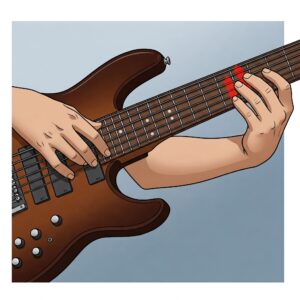
Boutique Beauty: Zon Sonus Special 6 Fretless
For players seeking the ultimate in custom craftsmanship, the Zon Sonus Special 6 Fretless represents one of the finest examples of luthiery in the bass world. Each instrument is essentially a custom creation, with numerous options available to tailor the bass to the player’s specific needs.
Key Features:
- Lightweight ash or alder body with figured exotic wood top
- 5-piece neck construction with carbon fiber reinforcement
- Custom Bartolini pickups and preamp system
- Phenolic or ebony fingerboard
- Extended upper register access
- Premium Hipshot hardware
- Average price: ~$4,800+
The Sonus Special’s most distinctive quality is its remarkable stability and consistency. The carbon fiber reinforcement and meticulous construction ensure that the neck remains true despite environmental changes – a crucial feature for a fretless instrument where slight neck movement can impact playability.
Tonally, the Zon offers exceptional clarity and articulation without sacrificing warmth. The custom electronics package allows for precise shaping of the instrument’s voice, from traditional upright-like tones to more modern, fusion-oriented sounds. While the price point puts it out of reach for many players, those who invest in a Zon typically find it to be a lifetime instrument that continues to inspire their playing for decades.
Best Value: Schecter SLS Elite-6 Fretless
For players seeking professional features without the boutique price tag, the Schecter SLS Elite-6 Fretless offers remarkable value. Combining modern design elements with premium components, this instrument punches well above its weight class in terms of playability and tone.
Key Features:
- Multi-laminate neck-through construction
- Swamp ash wings with figured maple top
- Ebony fingerboard with luminlay side dots
- EMG 45DC pickups
- Active 3-band EQ
- Ultra-thin C neck profile
- Average street price: ~$1,499
The SLS Elite-6 stands out for its modern approach to bass design. The neck-through construction provides excellent sustain and upper fret access, while the ultra-thin neck profile makes navigating the 6-string format more manageable, especially for players transitioning from narrower instruments.
The EMG pickups deliver the clarity and definition needed for fretless playing, with enough punch to cut through dense mixes. While some traditionalists might find the tone slightly more modern than vintage-styled instruments, the versatility of the 3-band EQ allows for a wide range of tonal options from warm and rounded to bright and articulate.
Best for Jazz: Warwick Thumb NT 6 Fretless
The Warwick Thumb NT 6 Fretless has earned its reputation as a premium instrument particularly well-suited to jazz contexts. With its distinctive growl and exceptional sustain, this German-crafted instrument offers a unique voice in the 6 string fretless world.
Key Features:
- Ovangkol or bubinga body with figured maple top
- Neck-through construction with wenge neck
- Wenge or tigerstripe ebony fingerboard
- Active MEC pickups and electronics
- Brass nut for enhanced sustain
- Warwick’s famous “Just-A-Nut” system for precise setup
- Average price: ~$3,799
What distinguishes the Thumb NT 6 is its distinctive midrange character – a growling quality that helps fretless lines cut through even in complex arrangements. The wenge fingerboard provides a smooth playing surface with slightly more resistance than ebony, giving players precise control over slides and vibrato.
The ergonomics of the Thumb, with its thumb rest and angled body design, make it surprisingly comfortable despite the wide neck requirements of a 6-string instrument. While the Warwick tone has a distinctive character that won’t suit every player or genre, those who connect with it often become lifelong devotees of the brand.
Let’s compare these top models across key performance factors:
| Model | Tone Quality | Playability | Versatility | Value | Best For |
|---|---|---|---|---|---|
| Ibanez GWB205 | Bright, defined | Excellent | Good | Excellent | Fusion, modern jazz |
| Sire M7 | Warm, vintage-inspired | Very good | Excellent | Outstanding | All-around use |
| Fodera Emperor 6 | Rich, detailed | Exceptional | Excellent | Good | Professional recording/touring |
| Zon Sonus Special 6 | Clear, articulate | Exceptional | Very good | Good | Custom specifications |
| Schecter SLS Elite-6 | Modern, punchy | Very good | Good | Excellent | Progressive styles |
| Warwick Thumb NT 6 | Growly, midrange-focused | Good | Good | Good | Jazz, fusion |
✨ Don’t Miss These Exclusive Deals! 🔥
➡ Ready to take the plunge into the world of 6 string fretless bass? These carefully selected instruments represent the best options across various price points and playing styles. Click on any highlighted model name to check current pricing and availability. Finding the right instrument now will help you develop your unique voice on this incredibly expressive instrument!
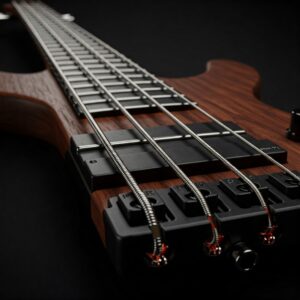
Essential Techniques for 6 String Fretless Bass
Mastering a 6 string fretless bass requires developing specific techniques that differ from both fretted bass playing and standard 4-string fretless. Here are the essential skills to focus on as you embark on your 6 string fretless journey.
Intonation Fundamentals
The most crucial skill for any fretless bassist is precise intonation – playing notes accurately in tune without the guidance of frets:
Ear Training: Develop your ability to hear slight pitch variations. Regular practice with a tuner or pitch reference is essential, especially when starting out. Apps like “Tonal Energy” or “InsTuner” provide visual feedback that can help train your ear-to-finger coordination.
Hand Position: Maintain a consistent left hand position relative to the fingerboard. Many players find that placing fingers directly over where the fret would be (rather than behind it as on a fretted bass) produces the most accurate pitch.
Finger Pressure: Apply even pressure with your fretting hand. Too much pressure can pull the note sharp; too little can result in buzzing or muted notes. Finding the right balance takes time but becomes intuitive with practice.
Visual Markers: Use the fret markers or lines (if your bass has them) as visual guides while developing muscle memory. Many professional players eventually become less dependent on these visual cues, but they’re valuable learning aids.
Extended Range Techniques
Having six strings creates both opportunities and challenges that require specific technical approaches:
String Crossing: Practice clean transitions between adjacent strings, focusing on maintaining even tone and volume. Exercises that involve moving through patterns across all six strings help develop this fundamental skill.
Three-Finger Right Hand Technique: While two-finger plucking works fine on 4-string bass, many 6 string players adopt a three-finger approach (index, middle, and ring fingers) to navigate the expanded range more efficiently. This technique, popularized by players like Gary Willis, allows for faster passages and more complex patterns.
Thumb Position: For playing in the upper register of the instrument, developing a comfortable and efficient thumb position technique (similar to upright bass players) can significantly improve access to the highest notes on all strings.
Expressive Techniques
The fretless format enables expressive techniques that set it apart from fretted instruments:
Vibrato: Develop a controlled, musical vibrato by rocking your fretting finger along the length of the string (not side to side as on a fretted instrument). Start slowly with wide vibrato and gradually refine it to suit different musical contexts.
Glissando: Practice smooth slides between notes, maintaining even pressure and consistent tone throughout the slide. This technique is a hallmark of fretless playing and contributes significantly to its vocal-like quality.
Microtonal Inflections: Experiment with subtle pitch bends and quarter-tone inflections to add expression to your lines. These can be particularly effective when emulating vocal phrasing or exploring non-Western musical traditions.
Harmonics: Natural and artificial harmonics on a fretless bass can create ethereal textures. Practice locating harmonics precisely, as the absence of frets makes this technique more challenging but also more rewarding when mastered.
Specific Challenges of 6 String Fretless
Some techniques require special attention due to the unique nature of the 6 string fretless format:
Muting Unused Strings: With six strings in close proximity, string muting becomes even more critical. Develop both right and left-hand muting techniques to prevent sympathetic vibrations and unwanted string noise.
Left Hand Stamina: The wider neck and increased tension require greater left hand strength and endurance. Focused exercises and gradual practice build the necessary muscular development without risking injury.
String Height Balance: Working with your luthier or technician to achieve optimal string height across all six strings is crucial. This typically involves a carefully balanced relief pattern in the neck to accommodate the different gauges and tensions.
Genre-Specific Approaches: Different musical contexts require adapted techniques:
- In jazz settings, focus on walking bass lines with subtle pitch inflections
- For fusion styles, develop precision in fast passages and complex harmonies
- In ambient or experimental contexts, explore extended techniques like tapping, harmonics, and textural approaches
Setting Up Your 6 String Fretless Bass
Proper setup is absolutely critical for any fretless bass, but especially for a 6 string instrument where the expanded range creates additional technical challenges. A well-set-up instrument will be significantly easier to play in tune and will better showcase the unique tonal qualities of fretless bass.
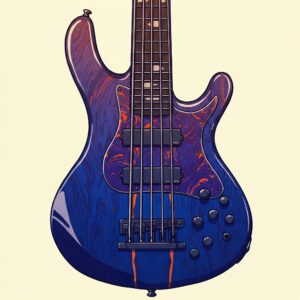
String Selection and Tension
Choosing the right strings for your 6 string fretless bass involves finding the optimal balance between tension, tone, and playability:
Flatwound vs. Roundwound: While traditional fretless wisdom favors flatwound strings for their smooth feel and reduced fingerboard wear, many contemporary players opt for roundwound or half-round strings for their increased brightness and articulation. If using roundwound strings, be aware that they may cause more wear on uncoated wooden fingerboards over time.
String Gauge: Finding the right string gauge balance is crucial for consistent tension across all six strings. Common configurations include:
- Light gauge: .030, .045, .065, .080, .100, .125
- Medium gauge: .032, .045, .065, .085, .105, .130
- Heavy gauge: .035, .055, .075, .095, .115, .135
String Material: Different materials offer distinct tonal characteristics:
- Stainless steel strings provide bright, articulate tone with excellent sustain
- Nickel-plated steel offers a warmer tone with good balance
- Pure nickel delivers vintage warmth but with less output
- Coated strings can protect both the strings and fingerboard while maintaining consistent tone for longer periods
Neck Relief and Action
The neck relief (the slight bow in the neck) and action (string height) are particularly important for fretless instruments:
Neck Relief: Most 6 string fretless basses benefit from slightly more relief than their fretted counterparts to accommodate the wider range of string gauges and playing dynamics. A typical starting point is around .012″ (0.3mm) of relief measured at the 8th position, but this may need adjustment based on your playing style and string gauge.
Action Height: Higher action typically provides cleaner note articulation and reduces buzzing, but too high will affect playability and intonation. A good starting point for string height measured at the 12th position is:
- Low B string: 2.0-2.5mm
- E string: 1.8-2.3mm
- A string: 1.7-2.2mm
- D string: 1.6-2.1mm
- G string: 1.5-2.0mm
- C string: 1.4-1.9mm
Saddle Adjustment: Each string’s individual saddle should be adjusted to ensure proper intonation across the entire range of the instrument. This is a delicate process on a fretless instrument and may benefit from professional setup.
Fingerboard Maintenance
The fingerboard of a fretless bass requires regular maintenance to ensure optimal playability and tone:
Cleaning: Regularly clean the fingerboard with appropriate products based on the material:
- For ebony and rosewood, use specialized fingerboard conditioners
- For phenolic or epoxy boards, a damp cloth is usually sufficient
- Always follow the manufacturer’s recommendations for your specific instrument
Hydration: Wooden fingerboards benefit from periodic conditioning to prevent drying and cracking. Products like lemon oil (for rosewood and ebony) help maintain proper hydration.
Polishing: Some players prefer a slightly polished fingerboard for smoother slides, while others prefer a more textured surface for better finger control. Finding your preference may require experimentation.
Amplification Considerations
Getting the best sound from your 6 string fretless bass requires attention to your amplification chain:
Preamp Settings: Most fretless bassists find that a slight midrange boost (around 800Hz-1kHz) helps accentuate the characteristic “mwah” tone. Consider reducing deep bass frequencies slightly to improve definition, especially when playing with the low B string.
Compression: A quality compressor can help even out the dynamics of fretless playing, particularly when incorporating techniques like sliding and harmonics. Start with moderate settings (2:1 ratio, medium attack and release) and adjust to taste.
Effects: While a pure fretless tone is beautiful on its own, certain effects can enhance its expressiveness:
- Subtle chorus or ensemble effects can add dimension
- Reverb (used sparingly) can enhance the vocal-like quality
- Octave effects can create interesting textures, especially when playing in the upper register
Cabinet Choices: Full-range cabinets that accurately reproduce both the deep lows of the B string and the singing highs of the C string work best for 6 string fretless basses. Many players prefer cabinets with 10″ or 12″ speakers for their balanced frequency response.
Recommended Products for 6 String Fretless Bass Players
Beyond the instruments themselves, certain accessories and products can significantly enhance your 6 string fretless bass experience. Here are some top recommendations:
La Bella 760N-B Black Nylon Tape Wound 6-String Bass Set
These premium flatwound strings represent an excellent balance between traditional fretless tone and modern playability. The black nylon tape wrapping provides a smooth feel that’s gentle on fingerboards while delivering a warm, rich tone that enhances the natural “mwah” of fretless playing. The balanced tension design ensures consistent feel across all six strings, making intonation more intuitive.
Dr. Duck’s Ax Wax Fingerboard Conditioner
This specially formulated fingerboard conditioner is perfect for maintaining wooden fingerboards on fretless basses. It provides proper hydration to prevent cracking and warping while creating a playing surface with just the right amount of smoothness for controlled slides. The non-toxic formula won’t damage finishes and helps extend the life of your fingerboard with regular application.
TC Electronic SpectraComp Bass Compressor Pedal
This compact yet powerful compressor was designed specifically for bass and excels with fretless instruments. The multi-band compression technology treats different frequency ranges independently, ensuring your low B string doesn’t cause pumping in the rest of your range. The TonePrint feature allows downloading artist-created settings optimized for fretless bass, making it easy to dial in the perfect sound.
K&K Sound Bass Max Pickup System
For players looking to add acoustic elements to their tone, this internal pickup system can be installed in most 6 string fretless basses. It captures the natural resonance and body sound that magnetic pickups might miss, particularly valuable for fretless instruments where these nuances contribute significantly to the overall sound. When blended with your bass’s existing electronics, it creates a rich, three-dimensional tone perfect for solo playing and intimate settings.
Dunlop System 65 Bass Maintenance Kit
Keeping your 6 string fretless bass in optimal condition requires regular maintenance, and this comprehensive kit includes everything needed. From fingerboard conditioning to body cleaning and polishing, the specialized formulations are safe for all finish types and fingerboard materials. The included microfiber cloths and detailing tools help maintain both the playability and appearance of your instrument.
✨ Elevate Your Fretless Experience Today! 🎸
➡ These specially selected products will help you get the most from your 6 string fretless bass. From premium strings that enhance that distinctive fretless tone to maintenance products that will keep your instrument in perfect playing condition, these recommendations represent the best options for serious fretless players. Click on any highlighted product to check current pricing and take your playing to the next level!
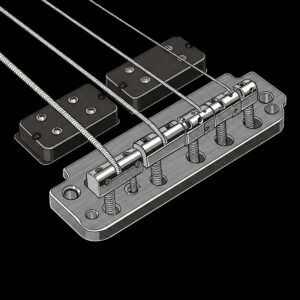
Learning Resources for 6 String Fretless Bass
The journey to mastering the 6 string fretless bass can be challenging, but with the right resources, you can develop the necessary skills more efficiently. Here are some of the best instructional materials, courses, and practice approaches specifically designed for this unique instrument.
Instructional Books and Methods
Several excellent books focus specifically on fretless bass technique, with some offering dedicated sections for extended-range instruments:
“The Fretless Bass” by Bunny Brunel and Josquin Des Pres provides comprehensive coverage of essential fretless techniques, from basic intonation exercises to advanced concepts. While not exclusively focused on 6-string, many of the exercises can be adapted for the extended range.
“Building Walking Bass Lines” by Ed Friedland offers invaluable guidance for developing walking bass lines on fretless. The concepts are particularly useful for 6 string players looking to incorporate the extended low and high range into traditional jazz contexts.
“Fretless Bass: A Hands-On Guide” by Bunny Brunel goes deep into the specifics of fretless technique with detailed illustrations and progressive exercises designed to develop both intonation and expression.
Online Courses and Video Instruction
Digital learning platforms offer excellent resources for 6 string fretless bass students:
Scott Devine’s “Fretless Bass Mastery” course at ScottsBassLessons.com provides structured video lessons covering everything from foundational intonation to advanced fretless-specific techniques. While primarily focused on 4 and 5-string instruments, the concepts transfer well to 6 string.
Gary Willis’ online instructional content including his “Fingerboard Harmony for Bass” course offers insights directly from one of the masters of 6 string fretless bass, with specific attention to the extended range and harmonic possibilities.
TrueFire’s bass instructional library features dedicated fretless courses from players like Michael Manring and Adam Nitti, with content specifically addressing the challenges of extended-range instruments.
Practice Tools and Apps
Technology can significantly accelerate your progress on fretless bass:
“Tonal Energy Tuner” app provides real-time visual feedback on intonation, allowing you to develop muscle memory and ear training simultaneously.
“Amazing Slow Downer” or similar audio-manipulation apps let you slow down difficult passages without changing pitch, ideal for transcribing and learning lines from fretless masters.
“iReal Pro” generates practice backing tracks in any key and style, providing an excellent practice environment for working on intonation in a musical context rather than in isolation.
Notable Players to Study
Studying the techniques and approaches of established 6 string fretless bassists can provide invaluable insights:
Gary Willis: Known for his work with Tribal Tech and his solo career, Willis is perhaps the most influential 6 string fretless player, renowned for his impeccable technique and innovative approach to harmony.
Matthew Garrison: Son of legendary jazz bassist Jimmy Garrison, Matthew has developed a highly personal style on 6 string fretless, incorporating advanced harmonics, chordal techniques, and electronic elements.
Steve Bailey: A pioneer of the 6 string fretless, Bailey’s techniques spans multiple genres from traditional jazz to fusion and beyond.
Michael Manring: While primarily known for his 4-string work, Manring occasionally performs on extended-range fretless instruments, showcasing innovative approaches to harmonics and alternate tunings.
Effective Practice Approaches
Beyond specific resources, certain practice approaches are particularly effective for developing 6 string fretless skills:
Slow Practice with Drones: Playing scales, arpeggios, and exercises against sustained drone notes helps develop intonation awareness. Start with simple major scales against their root note drone, gradually moving to more complex relationships.
Recording and Self-Evaluation: Regularly recording your practice sessions allows for objective assessment of your intonation and technique. What might sound acceptable in the moment often reveals opportunities for improvement when heard in playback.
Transcription Practice: Transcribing lines from both fretless bassists and other instruments (particularly vocals and fretless instruments like violin) helps develop both your ear and your understanding of how to utilize the expressive capabilities of the fretless fingerboard.
Incremental Speed Building: When working on technical exercises, use a metronome and increase speeds in very small increments (1-2 BPM at a time). This methodical approach builds clean technique and consistent intonation at all tempos.
The Future of 6 String Fretless Bass
As we look toward the future, several trends and innovations are shaping the evolution of the 6 string fretless bass. Understanding these developments can help you make informed decisions about your instrument choices and focus your technical development in relevant directions.
Technological Innovations
Recent advancements are expanding the possibilities for fretless bass players:
New Fingerboard Materials: Manufacturers are exploring advanced composites and treated woods that offer improved durability, consistency, and sustain. Materials like Richlite, carbon fiber composites, and specially stabilized woods provide alternatives to traditional options.
Multi-Scale Designs: “Fanned fret” or multi-scale designs (despite the ironic terminology for fretless instruments) are gaining popularity, offering improved string tension balance across all six strings. These designs feature a longer scale length for the lower strings and a shorter scale for the higher strings, creating more consistent tension and improved playability.
Integrated Electronics: Advanced preamp systems with programmable EQ curves, bluetooth connectivity for parameter adjustments, and integrated effects designed specifically for fretless tone are becoming more common in high-end instruments.
Alternative String Technologies: New string manufacturing processes are creating options with improved intonation, longer sustain, and enhanced durability – all critical factors for fretless instruments. Materials like cobalt alloys and various coatings offer new tonal possibilities.
Evolving Musical Applications
The musical contexts for 6 string fretless bass continue to expand:
Progressive Metal Integration: An increasing number of progressive metal bassists are incorporating 6 string fretless instruments into this traditionally fretted domain, bringing a new level of expressiveness to technical metal.
Electronic Music Applications: The unique tonal qualities of fretless bass combined with effects processing and looping technologies are creating new textures in electronic and ambient music genres.
Cross-Cultural Fusion: Musicians are leveraging the microtonal capabilities of fretless bass to authentically incorporate elements from Middle Eastern, Indian, and other non-Western musical traditions, creating exciting hybrid styles.
Neo-Classical Approaches: Some players are developing classical-inspired techniques on 6 string fretless, treating the instrument more like a cello or viola da gamba, complete with bow techniques (using specialized pickups that can capture these sounds).
The Custom Shop Revolution
The boutique instrument market is particularly vibrant for 6 string fretless basses:
Personalized Ergonomics: Custom builders are creating instruments with ergonomic features tailored to individual players’ bodies and playing styles – particularly valuable for the physically demanding 6 string format.
Tonal Customization: From wood selection to pickup placement and electronics configuration, the level of tonal customization available from boutique builders allows players to realize their specific sonic vision.
Aesthetic Innovation: Visual design elements that were once considered experimental have entered the mainstream, with custom shop instruments pushing boundaries in both materials and designs.
Sustainability Focus: Increasing emphasis on sustainable tonewoods and environmentally responsible manufacturing processes is influencing both large manufacturers and independent luthiers.
✨ Ready to Explore the World of 6 String Fretless Bass? 🎵
➡ Whether you’re ready to take the plunge with your first 6 string fretless bass or looking to upgrade your current instrument, the models and resources discussed in this guide provide excellent starting points for your journey. The unique expressive capabilities of these instruments open up new dimensions of musicality that can transform your playing and inspire creative growth for years to come.
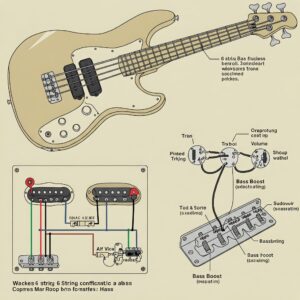
Conclusion: Is a 6 String Fretless Bass Right for You?
After exploring the many aspects of 6 string fretless basses – from their history and construction to playing techniques and maintenance – the question remains: is this specialized instrument the right choice for your musical journey?
Ideal Players for 6 String Fretless Bass
The 6 string fretless bass tends to be most rewarding for players who:
✅ Are drawn to expressive, vocal-like phrasing and the unique tonal qualities of fretless instruments
✅ Have a solid foundation on fretted bass and are looking to expand their musical vocabulary
✅ Play in musical contexts that benefit from extended range, such as jazz fusion, progressive rock, or experimental genres
✅ Have developed or are committed to developing good ear training and intonation skills
✅ Enjoy the challenge of mastering a demanding instrument that offers unique rewards
When to Consider Alternatives
There are legitimate reasons why a 6 string fretless might not be the ideal choice for everyone:
❌ If you’re a beginning bassist, the combined challenges of fretless intonation and navigating six strings might be overwhelming; consider starting with a 4-string fretted bass and gradually transitioning
❌ If you primarily play genres where fretless bass is rarely used (e.g., traditional rock, punk, or metal), the investment might not align with your musical goals
❌ If you have physical limitations such as small hands or certain injuries, the wide neck and string spacing might present unnecessary challenges
❌ If you need an instrument primarily for studio session work across diverse genres, a more versatile 4 or 5-string fretted bass might be more practical
A Balanced Perspective
Many professional bassists find that the ideal approach is not an either/or decision but rather maintaining both fretted and fretless instruments in their arsenal. This allows you to select the most appropriate tool for each musical situation while developing the unique skills associated with each instrument type.
For those who do choose to pursue the 6 string fretless bass, the journey offers tremendous rewards: a distinctive voice in the musical conversation, expanded creative possibilities, and the satisfaction of mastering an instrument that presents unique challenges and opportunities for expression.
Whatever path you choose, remember that the instrument itself is ultimately just a tool. The most important elements are your musicality, creativity, and commitment to developing your skills. With dedication and the right approach to learning, any bass – whether it has 4, 5, or 6 strings, frets or no frets – can become a powerful vehicle for your musical voice.
More FAQs
❓ How much does a quality 6 string fretless bass cost?
✅ Entry-level models start around $800-1000, mid-range options run $1500-2500, while professional instruments range from $3000-8000+... Factors affecting price include wood quality, electronics, hardware, and whether it's production or custom-built...
❓ Is it harder to play a 6 string fretless bass than a 4 string fretted bass?
✅ Yes, significantly more challenging due to the combination of wider neck, additional strings, and intonation demands... Players typically need 6-12 months of dedicated practice to develop reliable intonation and comfortable navigation of the extended range...
❓ What strings are best for a 6 string fretless bass?
✅ Flatwound or tapewound strings are traditionally preferred for their smooth feel and fingerboard protection... Many modern players use coated roundwound strings for brighter tone while minimizing fingerboard wear... String tension balance across all six strings is crucial for playability...
❓ Can I convert my 6 string fretted bass to fretless?
✅ Yes, but it requires professional luthier work for optimal results... The process involves removing frets, filling slots, refinishing the fingerboard, and comprehensive setup... Expect to invest $300-700 depending on materials and fingerboard complexity...
❓ Which 6 string fretless bass is best for jazz fusion?
✅ The Ibanez GWB205 Gary Willis Signature and Fodera Emperor 6 are top choices for jazz fusion... Both feature purpose-designed electronics that capture the articulation needed for fusion playing... The phenolic fingerboards on these models provide the characteristic mwah tone prized in fusion contexts...
Recommended for You:
- 10 Amazing Yamaha 5 String Bass Options That Will Transform Your Sound in 2025
- 10 Best Short Scale 5 String Bass Options for Compact Powerhouse Playing in 2025
- 5 Top 5 String Acoustic Electric Bass Guitar Options for Powerful Performance in 2025
Disclaimer: This article contains affiliate links. If you purchase products through these links, we may earn a small commission at no additional cost to you.
✨ Found this helpful? Share it with your friends! 💬🤗


